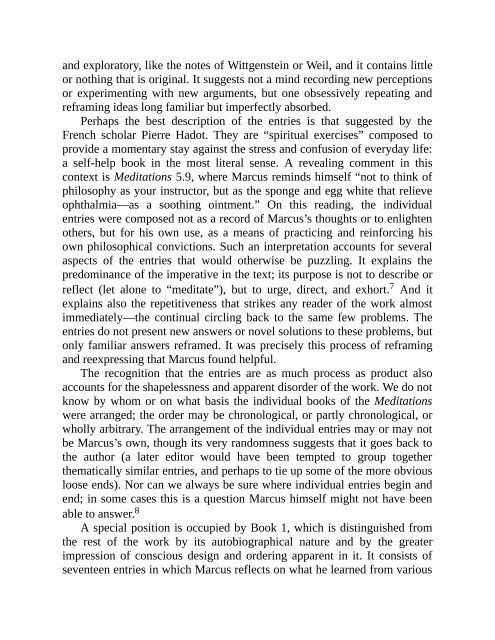9781945186240
Create successful ePaper yourself
Turn your PDF publications into a flip-book with our unique Google optimized e-Paper software.
and exploratory, like the notes of Wittgenstein or Weil, and it contains little<br />
or nothing that is original. It suggests not a mind recording new perceptions<br />
or experimenting with new arguments, but one obsessively repeating and<br />
reframing ideas long familiar but imperfectly absorbed.<br />
Perhaps the best description of the entries is that suggested by the<br />
French scholar Pierre Hadot. They are “spiritual exercises” composed to<br />
provide a momentary stay against the stress and confusion of everyday life:<br />
a self-help book in the most literal sense. A revealing comment in this<br />
context is Meditations 5.9, where Marcus reminds himself “not to think of<br />
philosophy as your instructor, but as the sponge and egg white that relieve<br />
ophthalmia—as a soothing ointment.” On this reading, the individual<br />
entries were composed not as a record of Marcus’s thoughts or to enlighten<br />
others, but for his own use, as a means of practicing and reinforcing his<br />
own philosophical convictions. Such an interpretation accounts for several<br />
aspects of the entries that would otherwise be puzzling. It explains the<br />
predominance of the imperative in the text; its purpose is not to describe or<br />
reflect (let alone to “meditate”), but to urge, direct, and exhort. 7 And it<br />
explains also the repetitiveness that strikes any reader of the work almost<br />
immediately—the continual circling back to the same few problems. The<br />
entries do not present new answers or novel solutions to these problems, but<br />
only familiar answers reframed. It was precisely this process of reframing<br />
and reexpressing that Marcus found helpful.<br />
The recognition that the entries are as much process as product also<br />
accounts for the shapelessness and apparent disorder of the work. We do not<br />
know by whom or on what basis the individual books of the Meditations<br />
were arranged; the order may be chronological, or partly chronological, or<br />
wholly arbitrary. The arrangement of the individual entries may or may not<br />
be Marcus’s own, though its very randomness suggests that it goes back to<br />
the author (a later editor would have been tempted to group together<br />
thematically similar entries, and perhaps to tie up some of the more obvious<br />
loose ends). Nor can we always be sure where individual entries begin and<br />
end; in some cases this is a question Marcus himself might not have been<br />
able to answer. 8<br />
A special position is occupied by Book 1, which is distinguished from<br />
the rest of the work by its autobiographical nature and by the greater<br />
impression of conscious design and ordering apparent in it. It consists of<br />
seventeen entries in which Marcus reflects on what he learned from various


